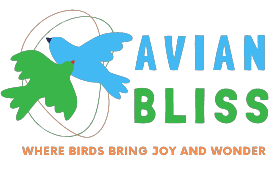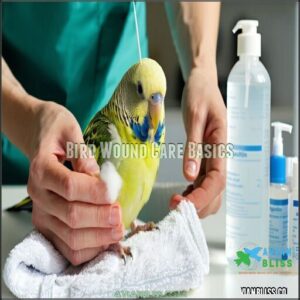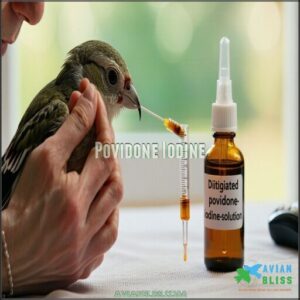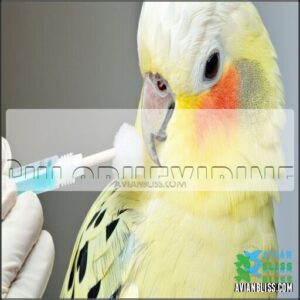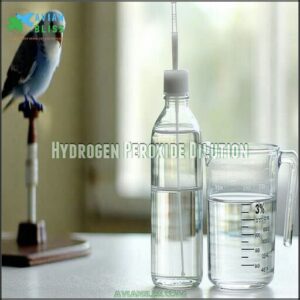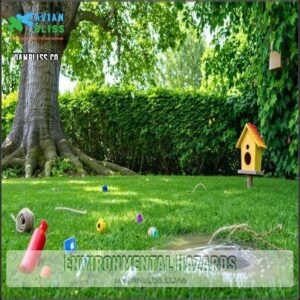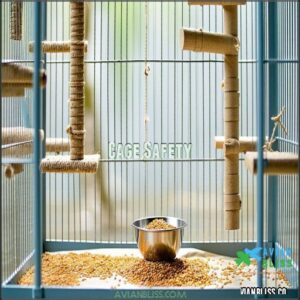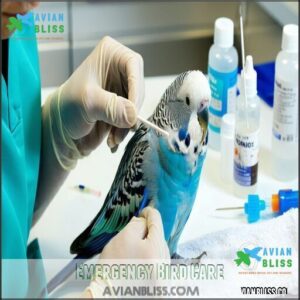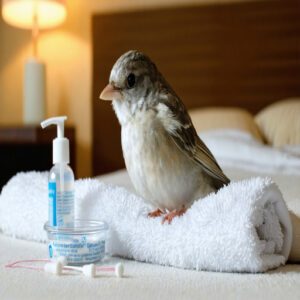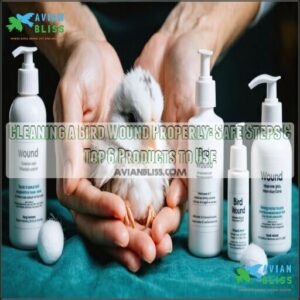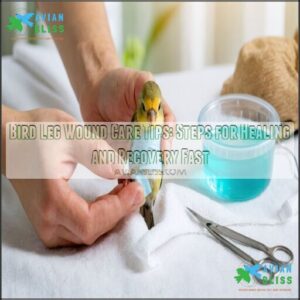This site is supported by our readers. We may earn a commission, at no cost to you, if you purchase through links.
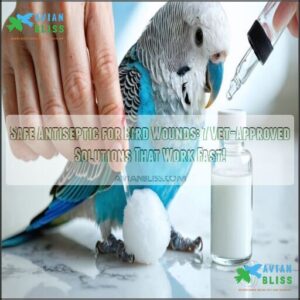 For safe antiseptic for bird wounds, you’ll want to use diluted chlorhexidine (0.05%) or povidone-iodine (Betadine) diluted to a weak tea color.
For safe antiseptic for bird wounds, you’ll want to use diluted chlorhexidine (0.05%) or povidone-iodine (Betadine) diluted to a weak tea color.
These solutions effectively clean wounds without harming your feathered friend. Never use alcohol, hydrogen peroxide, or Neosporin on birds as these can be toxic.
Clean the wound gently with sterile cotton balls, apply the antiseptic, and let it air dry. For deeper wounds, a vet visit is essential.
Birds hide illness instinctively, so quick treatment matters. Proper wound care prevents infection and speeds healing, while knowing which products to avoid can make all the difference between recovery and complications.
Table Of Contents
- Key Takeaways
- Bird Wound Care Basics
- Safe Antiseptics for Birds
- Top 3 Bird Wound Antiseptics
- Preventing Bird Injuries
- Emergency Bird Care
- Frequently Asked Questions (FAQs)
- What can I put on a bird wound?
- What should I do if my bird has a wound?
- Can Neosporin be used for bird wounds?
- What is the best antiseptic solution for a dog wound?
- What is a natural bird wound treatment?
- Can hydrogen peroxide be used on bird wounds?
- What can I put on a bird’s open wound?
- How do you treat a cut on a bird?
- What disinfectant is safe for birds?
- Can you put Neosporin on a bird wound?
- Conclusion
Key Takeaways
- Use diluted povidone iodine (Betadine) or chlorhexidine to safely clean bird wounds without causing harm.
- Avoid alcohol, hydrogen peroxide, and Neosporin as they can be toxic or damage delicate tissues.
- Clean wounds gently with sterile saline or antiseptics, then apply bird-safe antibiotic ointments without painkillers.
- Monitor the wound for signs of infection like redness, swelling, or discharge, and contact a vet if symptoms worsen.
Bird Wound Care Basics
You’ll need to act quickly when your bird sustains a wound, using only approved antiseptics and appropriate treatment techniques to prevent infection.
Proper wound care involves cleaning the injury with bird-safe solutions, applying suitable antibiotic ointments, and closely monitoring the healing process for any signs of complications.
Cleaning The Wound
Always clean your bird’s wound promptly to prevent infection.
First, assess the severity of the injury to determine if veterinary care is needed.
For minor wounds, gently rinse with sterile saline solution or diluted povidone iodine (1:10 ratio).
Pat dry with a clean cloth, avoiding cotton balls that can leave fibers.
Clean twice daily until healed, watching for signs of infection like redness or swelling.
Many owners source povidone iodine products specifically for avian care.
Applying Antibiotic Ointment
When applying antibiotic ointment to your bird’s wound, use a cotton swab to spread a thin layer over the cleaned area.
Choose bird-safe antibiotics without painkillers—never use human Neosporin with pain relief ingredients.
Apply just enough to cover the wound without excess that could be ingested during preening.
For deeper wounds, consider vet-approved alternatives like silver sulfadiazine cream before carefully bandaging the area.
Monitoring for Infection
Now that you’ve applied a bird-safe antibiotic ointment, you must watch for infection signs. Check your feathered friend’s wound twice daily.
Look for these telltale infection indicators:
- Redness spreading beyond the wound edges
- Swelling that increases rather than decreases
- Yellow or greenish discharge from the wound site
- Unusual wound odor or behavioral changes
Don’t wait if you notice these symptoms—contact your avian vet immediately.
Safe Antiseptics for Birds
You’ll need to use proper antiseptics specifically formulated for birds when treating wounds, as many common household products can be toxic to your feathered friends.
Veterinarians recommend diluted povidone iodine, chlorhexidine solutions, or properly diluted hydrogen peroxide to safely clean bird wounds without causing further harm or delaying the healing process.
Povidone Iodine
Now that you’ve properly cleaned the wound, povidone-iodine is your go-to bird wound antiseptic.
This broad-spectrum solution works effectively against both Gram-positive and Gram-negative organisms.
When using this avian antiseptic, remember that proper iodine concentration matters – dilute it to a weak tea color for safe application methods across all avian species.
Unlike other antiseptics, povidone-iodine offers longer-lasting protection with minimal toxicity levels for most wound types.
Many owners find specific avian products useful for wound care.
Chlorhexidine
While povidone iodine offers excellent protection, chlorhexidine provides even longer-lasting antimicrobial effects for your feathered friend.
This avian antiseptic binds to skin proteins, maintaining activity for up to two days.
For safe bird wound care, dilute the 2.0% chlorhexidine gluconate solution before application. Keep it away from eyes, ears, and mouth.
Unlike oily products that matt feathers, this water-based safe bird antiseptic won’t interfere with your bird’s natural insulation.
Various options exist for purchasing this antiseptic.
Hydrogen Peroxide Dilution
Hydrogen peroxide’s wound-healing properties make it valuable for bird care when properly diluted.
Hydrogen peroxide, when diluted correctly, offers a safe and effective way to clean bird wounds and prevent infections.
Mix 1 part 3% food-grade hydrogen peroxide with 9 parts water to create a safe 1% solution. Apply using cotton-tipped applicators for precision, then rinse with warm water.
This bird-safe antiseptic effectively stops bleeding and prevents infection without harming tissue.
Always avoid undiluted solutions and consider dilute betadine as an alternative option. You can also use povidone iodine for cleaning wounds.
Top 3 Bird Wound Antiseptics
You’ll find these three vet-approved antiseptics specifically formulated for bird wounds, offering fast-acting protection without the harsh chemicals that can harm your feathered friend.
These products combine powerful infection-fighting properties with gentle, bird-safe ingredients that promote healing while preventing complications, utilizing fast-acting protection.
1. F10 Antiseptic Ointment for Pets
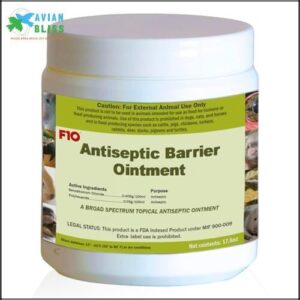
F10 Antiseptic Ointment stands out as a powerhouse solution for treating your feathered friend’s wounds.
This multi-purpose preparation effectively combats bacteria, fungi, viruses, and spores while creating a protective shield that lasts up to 5 days.
The lanolin ingredient helps restore skin viability and guarantees the ointment adheres properly to the wound area.
Available in various sizes (25g tubes, 100g, and 500g tubs), F10 is specifically formulated to be safe for birds and other exotic pets.
Its broad-spectrum efficacy makes it a trusted choice for avian care.
Best For: Pet owners seeking a safe, effective, and long-lasting antiseptic solution for birds and exotic animals.
- Broad-spectrum protection against bacteria, fungi, viruses, and spores.
- Residual effect lasts up to 5 days, reducing the need for frequent reapplication.
- Contains lanolin to support skin healing and improve ointment adherence.
- Must be kept out of reach of children.
- Limited to external use on pets only.
- May not be ideal for large-scale or industrial animal care needs.
2. PetSilver Chicken Wound Care Spray
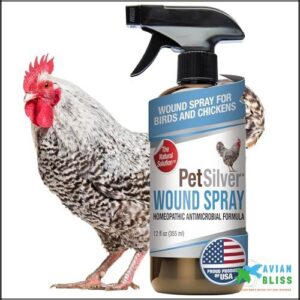
Treating your feathered friend’s wounds becomes markedly easier with PetSilver Chicken Wound Care Spray. This all-natural solution contains only chelated silver and distilled water, making it completely safe even when birds peck or lick the treated area.
You can apply it to any skin or feather area—including sensitive spots like the head, beak, feet, and wings. With its unique spray or stream option, you can treat injuries from up to 6 feet away, reducing stress for skittish birds.
Unlike stinging antiseptics, PetSilver provides immediate soothing relief while creating a protective healing barrier. For wound cleaning, consider using povidone iodine solutions as well.
Best For: Owners of chickens and birds seeking a safe, all-natural spray to treat wounds, cuts, and skin issues without irritation or harm from pecking.
- Only available in a 12 fl oz size, limiting larger usage needs.
- May not include additional antibacterial agents like povidone iodine.
- Higher price point at $28.47 compared to some alternatives.
- All-natural, FDA-registered formula safe for ingestion and skin.
- Easy application with spray or stream option from up to 6 feet away.
- Provides soothing relief without stinging or irritation.
3. Chicken Wound Care Spray for Birds
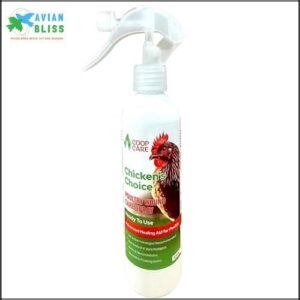
In times of emergency, Chicken Wound Care Spray can be your feathered friend’s best ally.
This advanced wound care solution is specifically formulated for birds, effectively treating bumblefoot, vent prolapse, pecking sores, burns, and other skin issues.
You’ll appreciate its proprietary ProH Technology that cleans wounds and promotes cellular healing without requiring bandages.
What’s more, it’s peck and lick safe when used as directed, with no staining or strong odors.
As an eco-friendly, biodegradable option made in the USA, it’s both veterinarian recommended and easy to apply during stressful situations.
Best For: Chicken owners looking for a safe and effective wound care spray to treat various poultry skin and wound issues.
- Promotes healing with ProH Technology, no bandages required.
- Peck and lick safe with no strong odors or stains.
- Eco-friendly, biodegradable, and made in the USA.
- Specifically designed for chickens, may not suit all livestock needs.
- Requires proper application to ensure effectiveness.
- Limited availability in some regions or stores.
Preventing Bird Injuries
You can prevent most bird injuries by regularly inspecting your bird’s environment for potential dangers like sharp objects, toxic plants, and unsecured toys.
Creating a bird-friendly space with safe perches and proper supervision during playtime will substantially reduce the risk of wounds that require antiseptic treatment.
Environmental Hazards
Awareness saves lives in the context of environmental hazards threatening your feathered friends.
Remove toxic plants like philodendron and lilies from your home. Prevent window strikes using decals or screens. Keep cats indoors to eliminate predation risks.
Choose birdsafe products and avoid pesticides or herbicides that harm birds. Replace unsafe toys with birdfriendly alternatives.
The Environmental Literacy Council recommends creating a hazard-free space to prevent injuries before they happen. It’s also important to follow hygiene best practices to protect them from disease, and maintain a safe environment for your feathered friends.
Supervising Playtime
Every playtime with your feathered friend requires your full attention to prevent injuries that might need bird wound care later.
Keep safe toys within reach and remove any potential hazards from the play area.
Watch for signs of fatigue during interaction techniques, as tired birds are more prone to accidents, making injury prevention a crucial aspect of play.
Always perform a post-play check to identify any minor injuries early, making it second nature.
Cage Safety
While supervising playtime protects your feathered friend, their cage environment requires equal attention. Ensuring cage safety prevents injuries that would need treatment with bird safe antiseptic.
Here’s how to create a birdfriendly environment:
- Check bar spacing is appropriate for your bird’s size
- Remove any toxic materials including zinc or lead-based paints
- Inspect toys regularly for loose parts or sharp edges
- Position perches at various heights with stable construction
- Verify cage construction is sturdy with no protruding wires
Emergency Bird Care
When your feathered friend is injured, you’ll need to act quickly with the right antiseptic solutions to prevent infection and promote healing.
You can control bleeding by applying gentle pressure with a clean cloth and using styptic powder before safely transporting your bird to a veterinarian for professional care.
Controlling Bleeding
When a bird is injured, stopping the bleeding is your first priority. Quick action can save your feathered friend’s life.
Here’s a quick reference guide for controlling bird bleeding:
| Wound Type | First Step | Follow-Up Action |
|---|---|---|
| Minor cuts | Apply gentle pressure | Clean with diluted antiseptic |
| Broken blood feather | Apply styptic powder | Never pull the feather out |
| Deep wounds | Apply pressure with clean gauze | Seek immediate vet care |
For bleeding control, keep styptic powder in your bird first aid kit. Apply gentle pressure with a clean cloth for 1-2 minutes, then address wound cleaning once bleeding stops. Remember to prioritize avian emergency preparedness by keeping vet contact information readily available, and consider visiting avian emergency preparedness for more information.
Transporting Injured Birds
Now that you’ve stopped the bleeding, proper transportation becomes your next priority.
When moving injured birds, safe containment is critical. Line a small cardboard box or carrier with soft towels for carrier preparation and stability.
Minimize stress by keeping the environment quiet and covering the container partially. For safe handling, wear gloves and support the bird’s entire body.
Maintain temperature control during transport, and call ahead to confirm your vet is prepared for your arrival.
Recognizing Signs of Illness
Now that you’ve safely transported your injured feathered friend, watch for these illness indicators.
Healthy birds are alert and active—any behavioral changes like lethargy or unusual posture warrant attention.
Check feather condition; fluffed or disheveled feathers often signal distress.
Listen for respiratory issues (wheezing, clicking), monitor appetite loss, and note changes in vocalizations.
These early warning signs, when caught quickly, can mean the difference between simple bird wound treatment and more serious bird infection treatment.
Frequently Asked Questions (FAQs)
What can I put on a bird wound?
For bird wounds, you can apply diluted povidone iodine or chlorhexidine as antiseptics.
Bird-safe antibiotic ointments work well too, and raw honey and pure aloe vera serve as natural alternatives.
Avoid alcohol-based products completely.
What should I do if my bird has a wound?
Nearly 70% of bird injuries are treatable at home with proper care.
Clean the wound with diluted Betadine or saline solution, apply bird-safe antibiotic ointment.
Seek veterinary care for serious injuries.
Can Neosporin be used for bird wounds?
Regular Neosporin isn’t recommended for your bird’s wounds as it contains ingredients that can be harmful.
You should only use bird-safe antibiotic ointments specifically recommended by an avian veterinarian for proper healing.
What is the best antiseptic solution for a dog wound?
Like a guardian shield for your furry friend, 2% chlorhexidine or diluted povidone-iodine are your best options. You’ll want to avoid alcohol and hydrogen peroxide as they can delay healing.
What is a natural bird wound treatment?
Honey works wonders for bird wounds due to its natural antimicrobial properties.
You can also apply diluted aloe vera gel to promote healing.
Both are safe, effective alternatives to chemical antiseptics for your feathered friend.
Can hydrogen peroxide be used on bird wounds?
By telegram or carrier pigeon, be warned.
Hydrogen peroxide can be used on bird wounds, but you’ll need to dilute it substantially (1:10 ratio with water) as full-strength solutions can damage delicate tissues, this is a critical consideration for treatment.
What can I put on a bird’s open wound?
For a bird’s open wound, you can use diluted povidone iodine (Betadine), saline solution, or bird-safe antibiotic ointment.
Never use alcohol or tea tree oil.
Always clean the wound gently before applying treatment.
How do you treat a cut on a bird?
Treating a bird’s cut is like performing delicate surgery on a tiny patient.
First, clean with diluted Betadine, apply styptic powder to stop bleeding.
Then use bird-safe antibiotic ointment and monitor closely.
What disinfectant is safe for birds?
Diluted Betadine (povidone iodine) or chlorhexidine are safe disinfectants for bird wounds.
Mix them with water to avoid irritation, and gently clean the area.
Always skip alcohol-based products—they’re too harsh for delicate avian skin.
Can you put Neosporin on a bird wound?
You can use Neosporin on a bird wound, but only the plain version without painkillers.
Apply it sparingly to avoid ingestion, and always consult an avian vet if the wound looks deep or infected.
Conclusion
Did you know birds can heal quickly with proper care?
Using a safe antiseptic for bird wounds, like diluted chlorhexidine or povidone-iodine, guarantees effective cleaning without causing harm. Avoid toxic products like alcohol or Neosporin, as they can worsen the injury.
Regular monitoring, gentle wound cleaning, and quick action can prevent infections and speed up recovery.
Always consult a vet for deep wounds or unusual symptoms. Your bird’s safety starts with knowing the right tools for care!
